|
|
 |
Fiche d'espèce de Copépode |
|
|
Cyclopoida ( Ordre ) |
|
|
|
Oncaeidae ( Famille ) |
|
|
|
Oncaea ( Genre ) |
|
|
| |
Oncaea bispinosa Böttger-Schnack, 2002 (F,M) | |
| | | | | | | Ref.: | | | Böttger-Schnack, 2002 (p.1111, Descr. F,M, figs.F,M); Böttger-Schnack & al., 2004 (p.1130, tab.1, Rem.) |  Issued from : R. Böttger-Schnack in Plankton Res., 2002, 24 (11). [p.1112, Fig.2]; Female (from Red Sea): A, habitus, typical form (dorsal; pore pattern on prosome not fully discerned); B, idem (lateral left side); C, urosome (dorsal; setae IV, V and VII on left side omitted); D, urosome (lateral right side; bi-articulation at base of seta VII figured separately); E, A1 [e, segment 2]; arrows indicating the position at which additional setae are present in most other oncaeid species, which are not found in O. bispinosa; F, caudal ramus (dorsal); G, expanded prosome (dorsal; pore pattern not discerned). Nota: Proportional lengths (%) of urosomites and caudal rami 7.3:63.4:4.0:3.6:1.2:10.5. Anal somite 1.3 times wider than long; 1.4 times longer than caudal rami.
Relative lengths (%) of segments of A1 measured along posterior non-setigerous margin 7.9:19.1:40.4:10.7:6.2:15.7. Several females were found, which exhibited a conspicuous expansion of the anterior prosome (fig.2,G). The same phenomenon was observed in O. zernovi in the Adriatic Sea and it occured regularly in O. zernovi populations from the northeastern Atlantic. Heron (1977) and Heron & al. (1984) reported specimens with an abnormal expansion of the prosome for several oncaeid species in the Pacific and related this deformation to internal cystic growth under tergite. In the case of O. bispinosa and O. zernovi, no internal cysts could be obserned, the expansion seemed to be related to the development of eggs in the body (?).
|
 Issued from : R. Böttger-Schnack in Plankton Res., 2002, 24 (11). [p.1114, Fig.3]; Female: A, A2; B, labrum (anterior); C, idem (posterior); D, md (showing individual elements); E, Mx1; F, mx2; G, Mxp.
|
 Issued from : R. Böttger-Schnack in Plankton Res., 2002, 24 (11). [p.1115, Fig.4]; Female: A, P1 (posterior; arrow indicating broad membrane between exopod segment 2 and 3 [a, idem, anterior, showing typical position of inwardly folded exopod, coxa and intercoxal sclerite omitted); B, P2 (anterior, arrow indicating small gap in serrated hyaline lamella on outer margin; C P3 (anterior); D, P4 (anterior) [d, intercoxal sclerite}.
|
 Issued from : R. Böttger-Schnack in Plankton Res., 2002, 24 (11). [p.1117, Fig.5]; Male (from Red Sea): A, habitus (dorsal); B, A1 [b, segment 2]; arrows indicating the position at which additional setae are present in most other oncaeid species, which are not found in O. bispinosa; ? mark indicating the position at which an aesthetasc is present in the female which was not found in the male; C, Mxp (anterior) [c1, idem, medial view, claw omitted; c2, inner margin of basis, posterior); D, urosome (dorsal, caudal ramus seta IV and V omitted); E, idem (ventral, left caudal ramus seta V omitted, spermatophores not fully developed); F, idem (lateralleft side, arrow indicating dorsal expansion on caudal ramus. Nota: Proportional lengths (%) of urosomites and caudal rami 7.5:59.9:4.1:3.3:3.3:10.7:11.2. Relative lengths (%) of segments of A1 measured along posterior non-setigerous margin 9.8:20.2:44.8:25.2. P5 exopod not delimited from somite, general shape and armature as in female, exceopt for exopodal setae being slightly shorter than in female; outer basal seta as in female. P6 reprezsented by posterolateral flap closing off genital apertiure on either side, ornamented with single denticle; posterolateral corners not protruding laterally and not well discernible in dorsal aspect.
|
 Issued from : R. Böttger-Schnack in Plankton Res., 2002, 24 (11). [p.1120, Table V]; Zoogeographical distribution of Oncaea zernovi Shmeleva and O. bispinosa sp. nov., identified by the outer spine connt on distal exopod segment of P2.
| | | | | Ref. compl.: | | | Nishibe & al., 2009 (p.491, Table 1: seasonal abundance); Abo-Taleb & Gharib, 2018 (p.139, Table 5, p.145, occurrence %) | | | | NZ: | 3 | | |
|
Carte de distribution de Oncaea bispinosa par zones géographiques
|
| | | | | | | Loc: | | | Red Sea (G. of Aqaba, Hurghada, Strait of Bab al Mandab), Arabian Sea, SE Indian ( NW Cape of Australia), Japan (Tosa Bay) | | | | N: | 3 | | | | Lg.: | | | (832) F: 0,34-0,31; M: 0,32-0,28; {F: 0,31-0,34; M: 0,28-0,32} | | | | Rem.: | epipelagic-mesopelagic.
For Böttger-Schnack (2002, p.1118) this species is a sistertaxon of O. zernoviSchmeleva, with which it has been confounded during earlier ecological studies in the Red and Arabian Seas. | | | Dernière mise à jour : 30/03/2020 | |
|
|
 Toute utilisation de ce site pour une publication sera mentionnée avec la référence suivante : Toute utilisation de ce site pour une publication sera mentionnée avec la référence suivante :
Razouls C., Desreumaux N., Kouwenberg J. et de Bovée F., 2005-2026. - Biodiversité des Copépodes planctoniques marins (morphologie, répartition géographique et données biologiques). Sorbonne Université, CNRS. Disponible sur http://copepodes.obs-banyuls.fr [Accédé le 07 janvier 2026] © copyright 2005-2026 Sorbonne Université, CNRS
|
|
 |
 |








